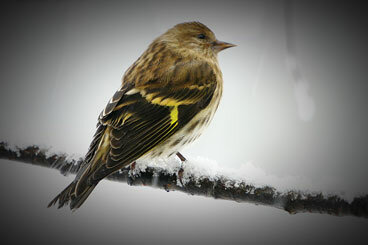
Photo courtesy Charles Martinez
This week’s Bird of the Week, compliments of the Weminuche Audubon Society and Audubon Rockies, is the pine siskin.
These birds are gregarious year-round, traveling in flocks to locate food, feeding and roosting together, and building nests near each other. Members are in constant contact with their “bzzzzzt” calls that keep the flock unified. If one shows up at your thistle feeder, several others are sure to follow.
This small, brown-streaked bird shows yellow patches in its wings and dark, notched tail, and has a slender, pointed bill. It is a resident bird in our area. As their name suggests, these birds extract the seeds of conifers but also eat a wide variety of other small seeds, including those of alder, grasses, rabbitbrush, weeds including thistle plants, and small insects and spiders. Their small size allows them to forage on tips of branches and stems, often upside down, to locate food unavailable to heavier birds.
Birds employ diverse strategies to eat in winter. Some migrate, either thousands of miles, only a few miles downslope, or distances in between, for a reliable winter food source. Some hide food in the fall, behind tree bark or buried in the ground, to serve as winter food stores. Many switch sources and eat what is currently available. Others like the pine siskin are nomadic in their search for food.
Several small finches like this one who live in the boreal forests of Canada and Alaska are tied to trees that don’t produce seeds every year. When cone crops are poor, they head south in large movements called irruptions in search of food, to the delight of birdwatchers who live outside their normal range. Birds which feed in close proximity at feeders can readily spread disease to each other and finches are especially vulnerable. Regular disinfection of feeders helps to keep birds healthy.
For information on events, visit www.weminucheaudubon.org and www.facebook.com/weminucheaudubon/.